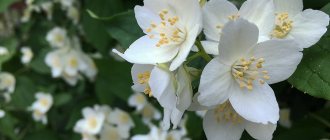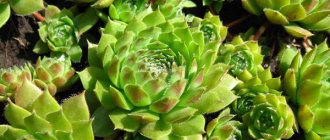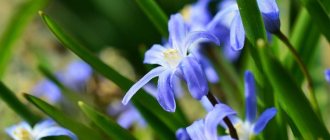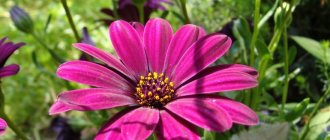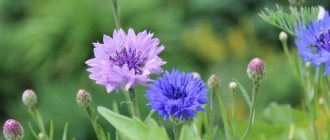The Legend of Dahlias
According to a legend that has survived to this day, the first graceful buds of fluffy flowers appeared on the site of a cooled fire, which was the last to go out during the glacial period of the era. Thus, it became a flower symbolizing the beginning of a new, more comfortable time.
Whether this is true or not is difficult to say. Most likely, the beautiful story was invented to popularize this unusual flower. Although even without mysterious fairy tales, the plant quickly found its admirers, first in Europe, where it came from the colonies, and then throughout the world.
Simple
Yellow Hammer
| |
Romeo
| |
Sneezy
|
A little history
Perennial dahlias are native to Mexico. They are considered the national symbol of this country and have long been an artifact of the Aztecs.
Mexican legends claim that the luxurious flower lived only in the royal garden for a long time, and only crowned heads could enjoy its charming appearance. But one day a loving gardener stole a blossoming bud and gave it to his bride. The girl was so amazed by the unusual petals and wonderful shades of the flower that she agreed to the marriage. And as a wedding gift she asked for the root of the plant. So the lovely flower got out into the wild.
Dahlias have a second name, little known even to advanced gardeners: Dali. Both names are associated with prominent botanists. In Russia, plants are often named in the feminine gender.
Collar
Fashion Monger
| |
Night Butterfly
| |
Alpen Mary Lloyd
|
Usage
Most often, perennial and annual dahlias are used as decoration for gardens, alleys, and flower beds.
The varieties of lovely flowers are so diverse that they adorn the exquisite creations of landscape designers, the ordinary flower beds of an ordinary owner of a country house, and even well-groomed flower beds near apartment buildings. Moreover, the question of how to plant dahlias will not become too difficult to resolve.
But the same Aztecs used dahlias as components for medicines, used them as an edible product, and made smoking pipes.
Short description
Dahlias
- Location . Dahlias are heat-loving plants. They grow well in sunny areas, protected from cold winds, with good air circulation. Low and wetlands are not suitable for planting dahlias in open ground.
- Illumination . The area should be well lit during the day for at least 6 hours
- Watering . It is necessary to water abundantly, but the soil should not be waterlogged. Dahlias do not tolerate either stagnant moisture or drought.
- Feeding . Organic or mineral fertilizers are applied 1-2 times a month
- Soil . Any soil is suitable for dahlias, but the best option is rich garden loam enriched with humus. Fertilized sandy soil is also suitable.
- Reproduction . By dividing tubers, cuttings, grafting or seeds
- Bloom . For different varieties - from July to late autumn
- Pests . Aphids, slugs, earwigs, caterpillars, thrips, horse flies, cutworms
- Diseases . Mold, fungal diseases, viral mosaic, powdery mildew, fusarium, gray mold, leaf spot
- Appearance care . It is necessary to remove faded flowers, stepsons and fading lower leaves
- Usage. Dahlias are used to create borders, flower beds and flower arrangements. Most varieties are used in free compositions and group plantings in flower beds. Dwarf varieties can be grown in pots and containers. Plants with long and strong flower stems are ideal for cutting
Kinds
The variety of dahlias is amazing. It is believed that you can decorate any area with different varieties and never repeat them. Flowers have such exquisite colors that they can decorate a garden in any style. Today there are about 15,000 varieties, and breeders continue to breed more and more new species.
Perennial dahlias are the most beloved, although they will require a little more attention to their needs. Similar green decorations are grown from thick roots, which must be removed before winter frosts.
Annual varieties are grown as seedlings. Usually they do not reach large sizes and comfortably frame flower beds and paths. But many gardeners turn annuals into perennial flowers. To do this, their tubers are dug up before the onset of cold weather, and in the spring they are planted again in the ground.
Peculiarities
Large-flowered variety Myrtle's Folly
Dahlias are a genus of herbaceous plants in the Asteraceae (Asteraceae) family. Under natural conditions, these perennials grow in the mountainous regions of Colombia, Mexico and Guatemala.
Dahlias are characterized by long and lush flowering. Almost the entire color palette is present in the color of the inflorescences, with the exception of blue and light blue shades.
Dahlias blooming
Dahlias are perennials that do not overwinter in open ground.
Every year, the above-ground part of these plants with hollow stems and feathery leaves dies. The underground part consists of large cone-shaped tubers connected to the root collar, on which vegetative buds are located.
These buds are absent on the tubers themselves, so the death of the neck leads to the death of the entire plant. For the winter, the tubers need to be dug out of the ground and stored indoors.
Height and varieties
Dahlias can be represented by tall fluffy bushes and very tiny plants.
The most traditional plants have become spherical, peony-shaped, anemone-shaped, pompom-shaped, and needle-shaped flowers.
Dahlias themselves belong to the Aster family. Indeed, many varieties resemble giant traditional autumn flowers. And the flowering time of both species coincides. The best time for the fluffy heads to bloom will be August-September. Although southern neighbors may bloom earlier and last longer in flower beds and lawns.
Ground cover (creeping) perennials blooming all summer: types, names, photos, description. TOP 10 best options for a summer residence- Clematis flowers - 70 photos of a beautiful flower. Planting, growing and care in open ground
Astilbe: planting, care. growing from seeds, photos, description of species
Anemoneaceae
Lambada
| |
Honey
| |
Phantom
|
Landing
Graceful and somewhat austere flowers emerge from dahlia tubers. Planting begins in late spring or early summer, when the threat of frost has passed and the soil becomes warm not only on the surface, but also at a shallow depth.
When planting nodules, special attention is paid to the growth points of the plant. They must be above the ground. Otherwise, the tiny shoots may begin to rot.
Pelargonium in open ground: planting, growing, care, reproduction, photoMarigolds: planting, growing, care and propagation in open ground. Overview of all types and varieties of marigold flowers
Flower seedlings - ideas, selection features and secrets of placing seedlings of annual and perennial plants
Some gardeners prefer to germinate flowers in a thick layer of sawdust covered with plastic film. In this case, it is necessary to monitor the humidity of the tubers and the access to fresh air.
When planting in early spring, future plants must be covered with covering material.
Reproduction
Flower garden with dahlias
Dahlias are propagated by dividing tubers, cuttings, grafting (rarely) or seeds. The peculiarity of these perennials is that with any of the propagation methods, the plants bloom in the first year.
When propagated by seed, the inflorescences of most new plants are of poor quality. During vegetative propagation, all qualities are transferred from the mother plants, so let’s take a closer look at these methods.
Tuber division
Healthy tubers
The division of tubers is carried out after their preliminary germination, shortly before planting in open ground. To germinate, they are transferred from storage to a warm, bright room, for example, in a greenhouse, and boxes are used that are filled with sawdust with a layer of 5-6 cm. Tubers are laid out on them, covered with sawdust up to the root collar and regularly watered with warm water.
The air temperature must be maintained within 16-20 degrees.
For propagation, well-developed young tubers without signs of infection with viral, fungal and bacterial diseases are used.
As soon as the buds wake up and sprout, the tubers need to be removed from the sawdust and divided into parts. They do it as follows.
Using a sharp garden knife, cut the root collar lengthwise so that each separated part has tubers and at least two or three eyes. The sections are sprinkled with charcoal powder, crushed sulfur or treated with brilliant green.
Bush with awakened buds
Depending on the size and number of awakened eyes, each bush can be cut into 3-6 parts.
The separated tubers are kept for 2-3 days, and then placed again in sawdust for further germination or, if the time has come for planting dahlias in the spring, they are planted in open ground. As a rule, dahlia tubers are sprouted in April, less often in March.
Dividing the bush
You can start germinating dahlias in March in boxes, pots or containers; such plants have time to set buds before they are planted in the ground. Plants must be replanted from pots carefully so as not to destroy the earthen ball.
Cuttings
Cuttings are cut with a sharp knife
This is the most productive method of propagating dahlias. The healthiest and most viable queen cells are selected for cuttings. With this method, the tubers begin to pre-germinate in February. Before the eyes awaken and shoots 1-2 cm long develop, plants can be kept in limited light conditions at an air temperature of 20-25 °C.
For further growth of shoots, plants require maximum illumination and a decrease in air temperature to 12-15 °C. At this time, watering of the queen cells is stopped, and frequent moderate spraying is carried out instead. This reduces the growth rate of shoots and prevents them from stretching.
When the sprouts reach 5-7 cm and form 2-3 pairs of leaves, they are carefully broken off or cut with a knife. Dense shoots with shortened internodes take root faster and better. Plants that develop from such cuttings begin to form high-quality tubers at an earlier date.
Cuttings with the so-called “heel” take root best, that is, cut so that on each there remains a piece of the root collar with a sprout. Cuttings without a “heel” root slowly and form inferior tubers - long and thin. In winter, such tubers may die.
Cutting separated from the mother plant
In place of the cut sprouts, new ones soon grow, but they are less suitable for reproduction. Therefore, as a rule, no more than 2-3 cuttings are taken from one place. For rooting, cuttings are planted in cups or boxes filled with a 7-8 cm layer of ordinary garden soil, on top of which a 2-3 cm layer of well-washed coarse sand is poured.
Planting a cutting
Before planting dahlia cuttings in boxes, water the soil generously with warm water. The cuttings are planted to a depth of 2-3 cm, making a distance between them of 5 cm. Plantings should not be thickened, as this leads to plant loss. The seedlings are sprayed with water, the boxes are covered with glass or film and shaded with white paper from direct sunlight. However, it should be remembered that sufficient light intensity is needed for root formation.
When planting cuttings, do not forget to sign the name of the variety
In addition to varietal characteristics, the rate of formation of the root system depends on the timing of cuttings. When cutting in January-February, 25-30 days are needed for rooting, when cutting in March - 15-20 days, and in April - 6-8 days.
The soil temperature for the first 7-10 days should be maintained within 20-22 °C, and the air temperature should be 17-19 °C. After 7-10 days, the paper is removed from the glass. For 5-7 days, the boxes are regularly ventilated by moving the glass, and then it is removed completely. Drafts should be avoided. After 10 days, the substrate temperature is reduced to 17-18 °C, and the air temperature to 14-15 °C. This will avoid creating imbalances in the development of roots or vegetative mass.
Dahlia cuttings in cups
Rooted cuttings are transplanted into pots or cups with a diameter of 9 centimeters. After picking into small containers, young plants form round compact tubers. If the plants are left in boxes until planted in the ground, the tubers will be of poor quality - long and thin.
For rooting, you can also use perlite with a granule size of 3-5 mm. It provides sufficient moisture and air supply necessary for the rapid development of roots. In addition, perlite creates sterile conditions under which cuttings are less susceptible to fungal diseases.
When cuttings in late April - early May, it is better to use a mixture of perlite with well-weathered peat as a substrate. For every part of perlite add 2-3 parts of peat. This contributes to less damage to young roots when transplanting cuttings. This substrate is leveled, lightly compacted and moistened with water.
A young plant transplanted into open ground
It is better to immediately plant the largest cuttings of January and February harvesting dates in pots half filled with fertile soil and with sand on top. In pots, such cuttings take root better and subsequently the plants develop well. Delenki are planted in open ground when the threat of return frosts has passed.
Watering
Humidity will become almost the only requirement when deciding how to plant dahlias.
Seedlings and tubers will require a drainage layer of gravel, brick, and pebbles to remove excess moisture. After each rain, it is better to loosen the soil so that the water does not stagnate.
Flower clocks - designer tips, methods of use and original ideas for flower clocks (105 photos + video)- Low-growing flowers - types, descriptions and ideas for use in landscape design (100 photos and videos)
Flowers for a flower bed - basic design rules and ideas for creating the perfect flower garden (110 photos and videos)
Watering must be moderate so that the tubers do not rot.
Globular
Dark Spirit
| |
Wizard of Oz (Wizard Of Oz)
|
Diseases
Gray rot is considered the most common nuisance; it appears as a result of excessive watering or excess nitrogen.
Symptoms of the development of the disease will be a gray coating on the buds, crooked flowers or brown spots. Effective treatment will be rapid removal of the affected areas.
The second disease is fusarium and white rot. High-quality culling of roots before planting, timely and rather ruthless removal of diseased plants will help to avoid such problems.
Nymphaeaceae family
Gerrie Hoek
| |
Bahama Red
| |
Angela
|
Flower care
Dahlias, like all other garden plants, require attention. Caring for these flowers is not difficult and even a novice gardener can easily cope with it. Particularly large inflorescences are obtained if excess lateral branches are removed from the stem in a timely manner. In gardening, this action is called pinching. The best results are obtained when forming a bush of two to three stems.
The procedure for removing new shoots must be carried out throughout the entire season, since they tend to appear at the base of the leaf again and again.
Dahlias need to be watered at least twice a week in the evening. Watering is carried out directly at the root. The rhizome should not be over-watered. The plant should not stand in water, as this will lead to rotting of the root system. It is necessary to feed dahlias constantly during the period of active growth. Wood ash, infusion of chicken manure, and chemical mixtures purchased in specialized stores are used as fertilizer.
Pinching flowers
If a sufficient amount of fertilizer was placed in the hole during planting, then fertilizing begins only after green mass has formed on the bush. In cases where the plant was planted in a hole without fertilizers, you need to start feeding dahlias within a week.
Dry subcortexing is done quite simply; for this, several holes are dug around the perimeter of the bush, into which nutrient material is placed. After this, the bed is leveled with a rake. Plants are fed approximately once every two weeks.
Cactaceae
Fringed Star
| |
Friguolet
|
Pompons
Little Robert
| |
Deepest Yellow
|
Semi-cactus
Ice Princess
| |
Adlerstein
|
FAQ
How to stimulate dahlias to bloom?
Faded flowers should always be cut back along with the stem before the next branching occurs. This promotes the formation of new side shoots and buds. You should also pay attention to the place where dahlias are planted. Rare flowering may be caused by a place that is too shady. In addition, for abundant flowering, dahlias need a sufficient amount of water, fertilizer and soil rich in humus.
What should you pay attention to when growing tall dahlia varieties?
It is important that tall dahlias are located in a place protected from the wind. Individual stems are not very strong and can break easily. Therefore, it is always a good idea to give your plants extra support once they reach their full height in the summer. Heavy flower heads can also break stems. Therefore, they should be tied to a stick until the dahlias fade.
Are the characteristics of different varieties of dahlias the same?
In principle, the basic characteristics of all varieties of dahlias are the same. They are distinguished by their growth height, which can range from 40 to 180 cm, and flowering, which varies depending on the variety. Otherwise, all dahlias are characterized by unbranched, upward-growing stems, each with a flower at the top. The leaves are oval, dark green.



